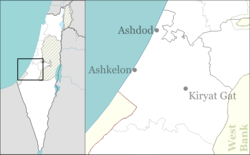Beit Guvrin, Israel
| Beit Guvrin | |
|---|---|
|
| |
 Beit Guvrin | |
| Coordinates: 31°36′47.15″N 34°53′53.87″E / 31.6130972°N 34.8982972°ECoordinates: 31°36′47.15″N 34°53′53.87″E / 31.6130972°N 34.8982972°E | |
| District | Southern |
| Council | Yoav |
| Affiliation | Kibbutz Movement |
| Founded | 1949 |
| Founded by | Former Palmach members |
| Population (2015)[1] | 436 |
Beit Guvrin (Hebrew: בֵּית גֻּבְרִין, lit. House of Men in Aramaic) is a kibbutz in the Lakhish region, west of the ancient city of Beit Guvrin, for which it is named. Located 14 kilometres east of Kiryat Gat, it falls under the jurisdiction of Yoav Regional Council. In 2015 it had a population of 414.
History
The kibbutz was established on a site with a long history. Originally an Iron Age town named Maresha, it became a town named Beit Guvrin, which was later renamed Eleutheropolis, "the city of free men" by the Romans in 200 CE. It was later the site of a Frankish colony, "Bethgibelin", before becoming the Arab village Bayt Jibrin.
Kibbutz Beit Guvrin was founded in 1949, on the eve of Shavuot, by former Palmach members after the residents of Bayt Jibrin fled following a military assault by Jewish forces during the 1948 Arab–Israeli War.[2] The first residents were members of the "Yetzivim" youth group, which immigrated from Turkey in 1945, and the "Bnei Horin" youth group, which immigrated from Romania in 1946.
Economy
The economy was formerly based on chicken coops, cowsheds and field crops. BG Technologies is located on the kibbutz. Other kibbutz-run businesses are a banquet hall, a clothing and gift store, a jewelry store, a dental clinic and a public swimming pool.[3]
Landmarks
The kibbutz is surrounded by antiquities from the 1st century BC – 2nd-century CE town of Beit Guvrin.[4] the Beit Guvrin-Maresha National Park is a popular tourist destination which includes Hellenistic-period caves with wall paintings, columbaria, a Roman city and ruins of a Crusader castle.
The area is surrounded by many Islamic shrines (maqam) like Nabi Jibrin, Sheikh Mahmoud, etc., but the holiest of them is Maqam Tamim al-Dari dedicated to a companion of Muhammad who had control over the Hebron district which included the Cave of the Patriarchs. Today all the Muslim shrines are abandoned.
References
- ↑ "List of localities, in Alphabetical order" (PDF). Israel Central Bureau of Statistics. Retrieved 16 October 2016.
- ↑ Morris, Benny (2004). The Birth of the Palestinian Refugee Problem Revisited. p. XIX, village #322. Gives the cause and date of depopulation, p xxii #166.
- ↑ Beit Guvrin Archived November 4, 2013, at the Wayback Machine. Yoav Experience
- ↑ Around Jerusalem and the Dead Sea Fodors